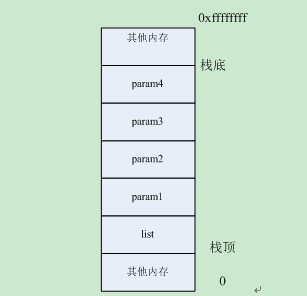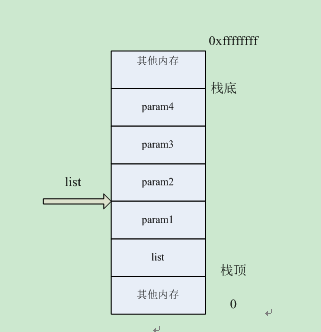转自:https://blog.csdn.net/f110300641/article/details/83822290
在ANSI C中,这些宏的定义位于stdarg.h中:
typedef char *va_list;
va_start宏,获取可变参数列表的第一个参数的地址(list是类型为va_list的指针,param1是可变参数最左边的参数):
#define va_start(list,param1) ( list = (va_list)¶m1+ sizeof(param1) )
va_arg宏,获取可变参数的当前参数,返回指定类型并将指针指向下一参数(mode参数描述了当前参数的类型):
#define va_arg(list,mode) ( (mode *) ( list += sizeof(mode) ) )[-1]
va_end宏,清空va_list可变参数列表:
#define va_end(list) ( list = (va_list)0 )
注:以上sizeof()只是为了说明工作原理,实际实现中,增加的字节数需保证为为int的整数倍
如:#define _INTSIZEOF(n) ( (sizeof(n) + sizeof(int) - 1) & ~(sizeof(int) - 1) )
为了理解这些宏的作用,我们必须先搞清楚:C语言中函数参数的内存布局。首先,函数参数是存储在栈中的,函数参数从右往左依次入栈。
以下面函数为讨论对象:
void test(char *para1,char *param2,char *param3, char *param4) { va_list list; ...... return; }
在linux中,栈由高地址往低地址生长,调用test函数时,其参数入栈情况如下:

当调用va_start(list,param1) 时:list指针指向情况对应下图:

最复杂的宏是va_arg。
-
-
-
-
void var_test(char *format, ...)
-
{
-
va_list list;
-
va_start(list,format);
-
-
char *ch;
-
while(1)
-
{
-
ch = va_arg(list, char *);
-
-
if(strcmp(ch,"") == 0)
-
{
-
printf(" ");
-
break;
-
}
-
printf("%s ",ch);
-
}
-
va_end(list);
-
}
-
-
int main()
-
{
-
var_test("test","this","is","a","test","");
-
return 0;
-
}
附:可变参数应用实例
1.printf实现
-
-
-
int printf(char *format, ...)
-
{
-
va_list ap;
-
int n;
-
-
va_start(ap, format);
-
n = vprintf(format, ap);
-
va_end(ap);
-
return n;
-
}
2.定制错误打印函数error
-
-
-
-
void error(char *format, ...)
-
{
-
va_list ap;
-
va_start(ap, format);
-
fprintf(stderr, "Error: ");
-
vfprintf(stderr, format, ap);
-
va_end(ap);
-
fprintf(stderr, " ");
-
return;
-